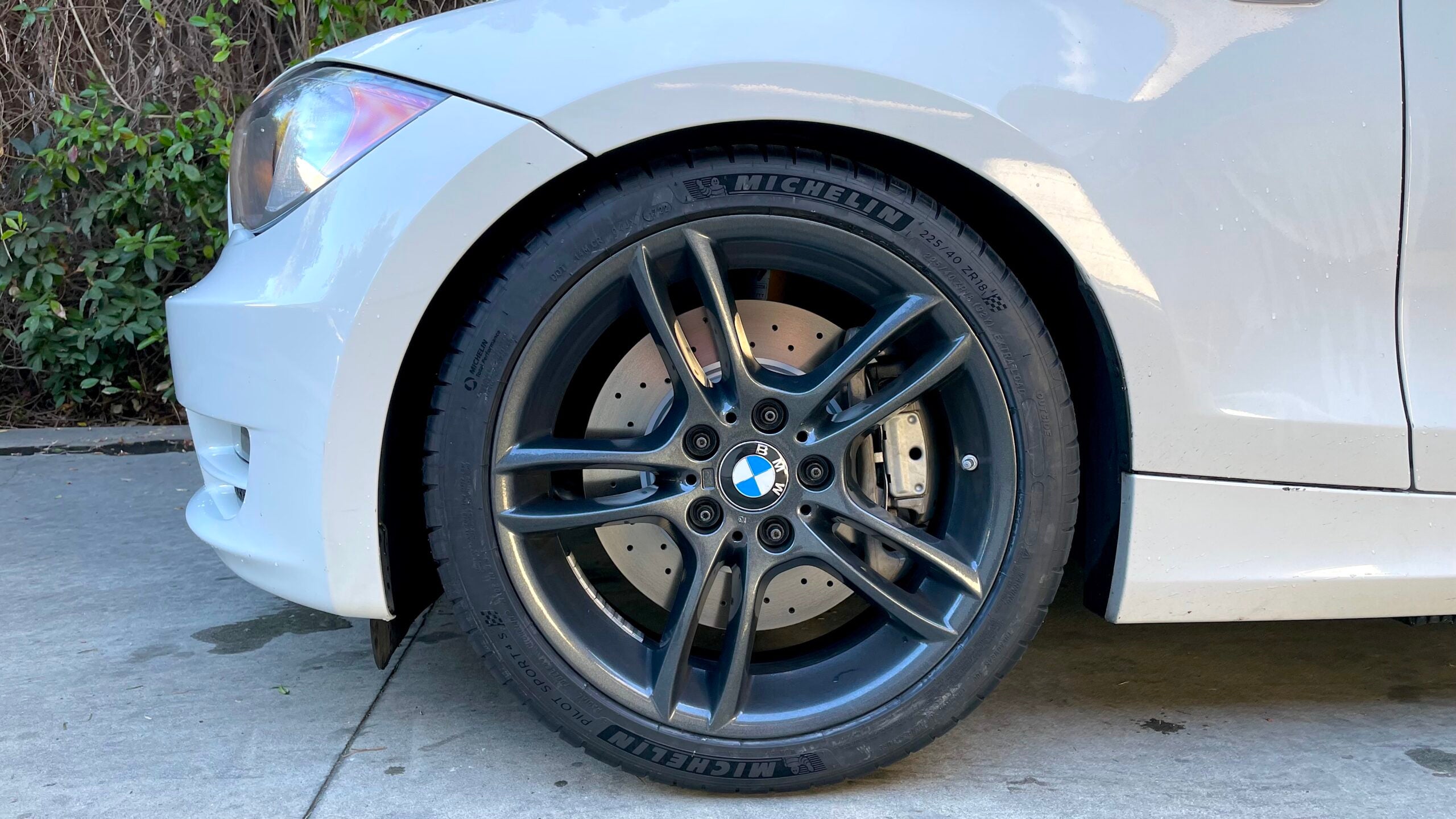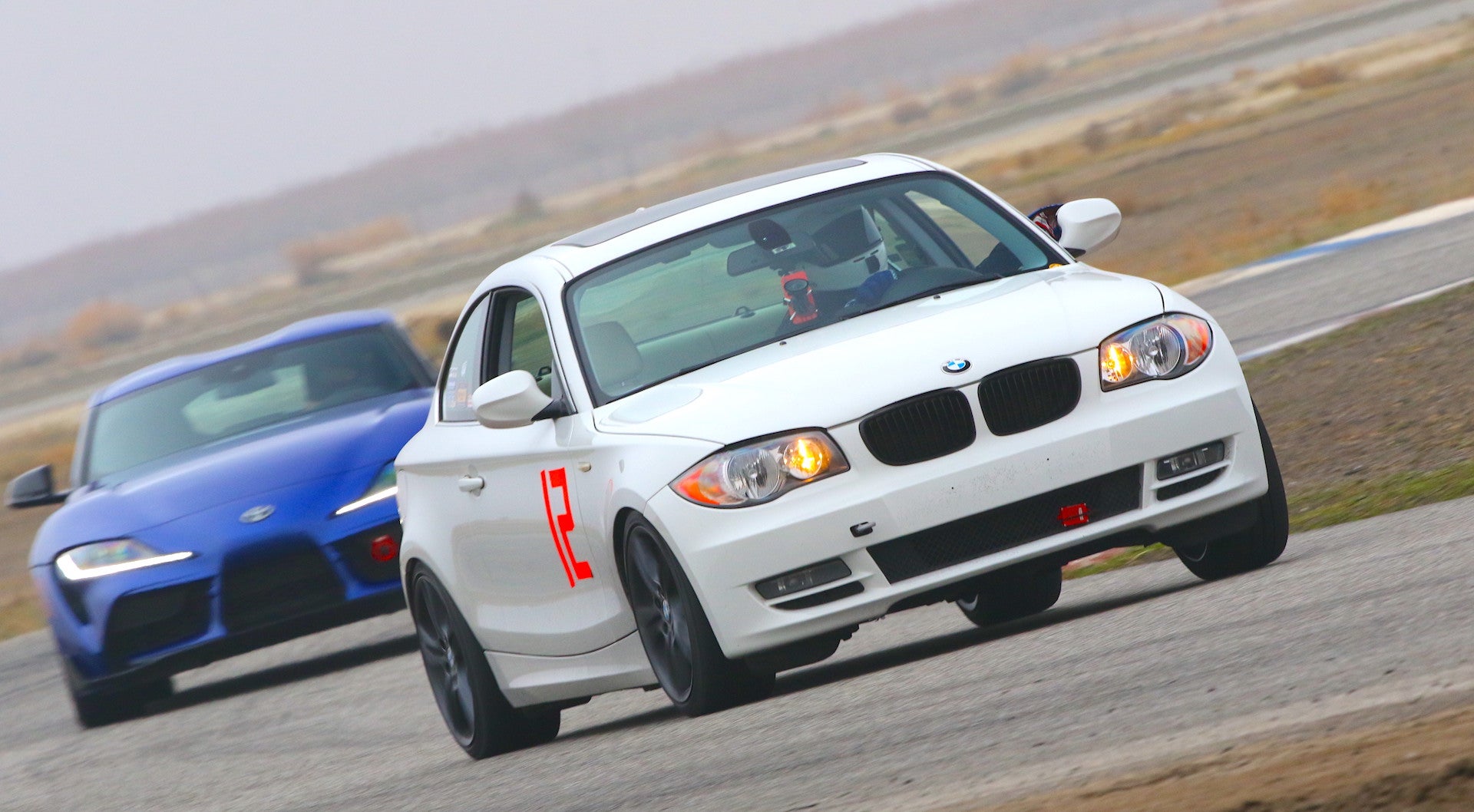I've put a ton of work into my 2011 BMW 128i. Recently, after installing a factory-sourced horsepower upgrade, a limited slip differential to get the rear tires to grip harder, and more stopping power, I was able to reap the benefits at my home away from home: Buttonwillow Raceway Park. My wrenching paid off in faster lap times, and I couldn't be more excited.
What's cooler was that I got to experience it all while competing in the final round of Bimmer Challenge with Speed Ventures, a California-based BMW time attack challenge series. Previously, I took part in the dead of summer when ambient and track temperatures were quite immense. However, this recent winter showdown brought out all of the season's heavyweights. There was no chance of reaching the podium, but it'd be a good chance to gauge competition for next year.
Despite throwing more weight onto the 128, I was still able to drop my personal best lap time by over three seconds—from a 2:14.99 to a 2:11.46.
Here's how it went down.
Is This What the Youths Call "Sandbagging"?
My current track wheel and tire setup is getting a little tired, and no, I'm not talking about how it looks. I'm still enthralled by how good the 17X8.5 Apex ARC-8s look bolted up to the E82's tight, slightly athletic bodywork. What I mean is the Accelera 651 Sport Xtra tires are at the end of the road, so to speak. Between putting in the work on track, curvy mountain roads, as well as being crucial to familiarizing myself with the Wavetrac limited-slip differential, they were pretty much done.
In fact, I wasn't sure if they had more than two track sessions left in them before they'd start exposing their metallic innards. That meant my original plan was to throw them in the trunk/rear seats, and drive to and from the track on my set of freshly powder-coated BMW Style 261s with very new Michelin Pilot Sport 4S tires. But then I had an epiphany. The Michelins are in better overall condition and are more grippy on the street. Why don't I see how they fare on track?
This proved to be a good decision, especially considering the very low (for Central California) ambient temperatures at Buttonwillow that hovered around 35 degrees in the early morning and got to 44 by the end of the day. It was a miserably overcast day, but at least it wasn't windy and/or rainy.
The tires seemed to love starting out at 28 PSI cold at all four corners, and never got too greasy. When I came into the pits, none of the pressures were above 37. Based on my mild forum research, this was the maximum that they should see before potentially chunking up. The soft sidewalls didn't bode well for cornering confidence, but the tires had a surprising amount of grip for a 300 treadwear rating.
Each wheel is five more pounds than each Apex ARC-8, and I was rocking 10 more pounds on the front axle due to my freshly installed 335i brakes. The weight didn't matter, as it still all paid off handsomely.

More Braking Force and More Mechanical Grip
The 335i brakes—consisting of Zimmermann drilled rotors and Ferodo DS2500 pads—felt good on track, though not as amazing as I'd hoped. I think this was rooted in the pads, as I made sure to bleed the brakes with a fresh bottle of Castrol SRF the day before.
The brakes had great stopping power and never got anywhere near being overwhelmed. Pedal feel left a lot to be desired, however, as I couldn't quite modulate them as precisely as I could with the previous Hawk HP Plus pads. Pedal travel was longer than I prefer, too. Though, some squishiness from the softer sidewall tires might've had a slight hand in the former. Still, they were definitely an overall upgrade, and I can't fault their ability to never not slow me down.
What truly performed was the far-improved mechanical grip from the Wavetrac limited-slip differential. Buttonwillow's tricky On-Ramp corner is usually tough on differentials and feels incredibly awkward with open fare bolted up. Previously, the 128's rear end would shuffle out of it and sometimes break traction completely. Now, it puts down the power effectively and undramatically boosts speed into the following straight by a very noticeable margin. Even when I attempted to put my foot down too early and at the wrong steering angle to try and upset the rear end, it still stuck to the tarmac like glue.
Overall corner-exit acceleration was vastly improved, as was my confidence in overall grip. It took a lot to get it to step out with traction control off, and when it did, it was usually only on my first hot lap when the tires weren't quite yet up to temperature. I was shocked at the speeds it could maintain from the exit of Bus Stop all the way to the track's infamous Phil Hill.
By that same token, off-track excursions were less dramatic, too. Dropping two wheels off at the exit of Bus Stop, as well as a scary moment at the exit of the Esses, felt more stable than I'm used to. Any way to lessen the chance of spinning at over 90 mph heading toward the final corner of the track is a good thing!

More Power
More power is more power, and the bump from the three-stage intake manifold was excellent, especially in the top end of the N52's rev range. The mighty aluminum-magnesium lump revved up more enthusiastically and made the 128 hit new highs in top speed, reaching as high as 104 mph before braking into the final corner where previously it had trouble hitting 102. Two mph doesn't sound like much, but it's a big margin in the grand scheme of dropping lap times. My speed heading up to Phil Hill maxed out at 97 mph after the bump, too, where previously I couldn't quite reach 94, and 92 into Cotton Corners compared to a previous best of 87. I'll admit that a good chunk of the latter is most likely due to being able to put down power sooner out of Cotton Corners thanks to the Wavetrac.
However, the real comparison was the front straight before braking for turn 1, as my cornering speed coming through the final corner was pretty much the same between this visit and my last. Here, where it'd previously top out at 96 mph, now it hits 102.
As a nice bonus, consuming all this data via my Apex Pro app revealed (future blog on this incoming) an easy way to ensure that my next laps will be faster—be quicker with my transitions between the gas to the brake pedal. Data shows that my foot lingers between the two and allows coasting for just a tad too long, which could be all it takes to stay off the podium in next year's season of Bimmer Challenge. I definitely have to work on being more precise in this area.
Bring It On
It's safe to say that I'm excited about what 2023 will bring. As long as I keep an eye on the 128 and ensure it's always running tip-top, my plan is to hit the track with a bit more frequency.
I'm a little annoyed with myself for not throwing on the 335i brakes sooner, but at least they're on there now after I've become more familiar with the chassis. Perhaps the stock brakes inadvertently caused me to send it harder into corners?
I still have to do proper damper tuning, too! I'll definitely mess with rebound adjustment at the next Bimmer Challenge round. Or, even before—here's to the never-ending quest of fiddling.
The Drive and its partners may earn a commission if you purchase a product through one of our links. Read more.
More on The Autance
- Bolting up a three-stage intake manifold to my BMW's engine was generally easy
- I'm glad I swapped wheel bolts for wheel studs
- Interior changes always make a big difference
- Tracking affects your car's maintenance schedule for sure
- It's wild how much of a difference bringing the steering wheel closer can make









